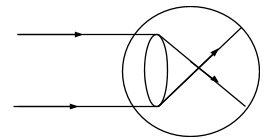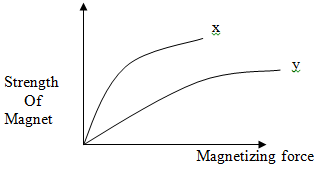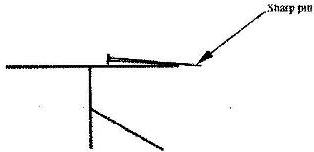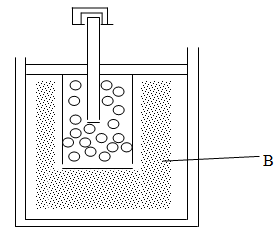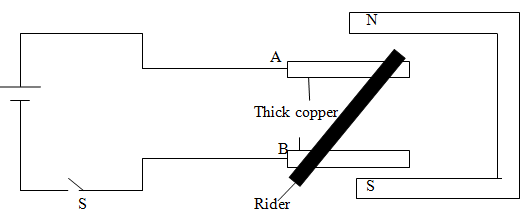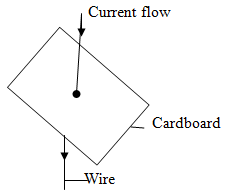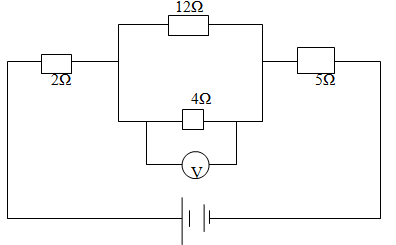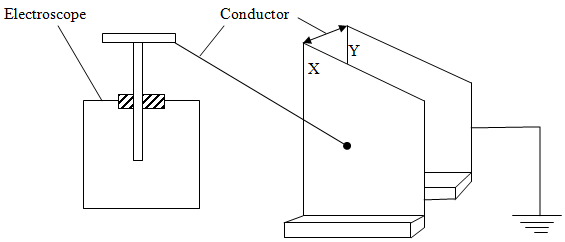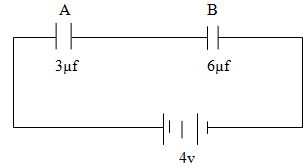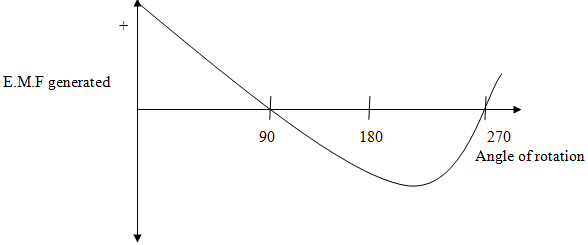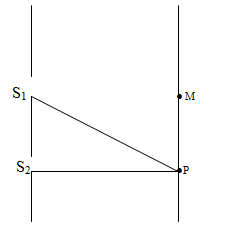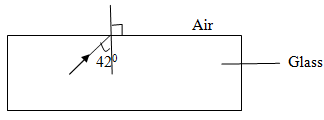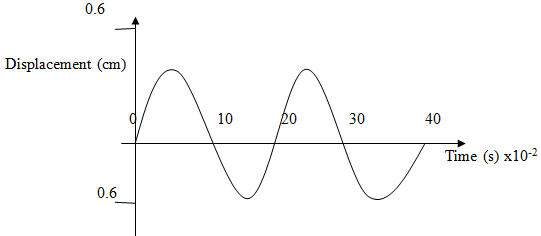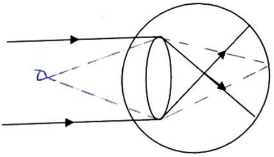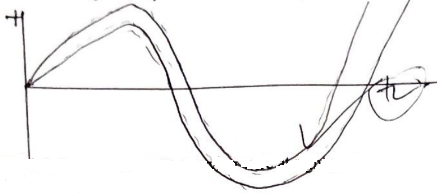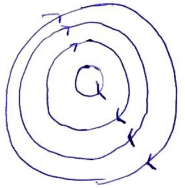INSTRUCTIONS TO CANDIDATES
- This paper consists of two sections, A and B.
- Answer ALL the questions in the spaces provided.
- All working must be shown clearly in the spaces provided in this booklet.
- Mathematical tables and electronic calculators may be used.
SECTION A (25 MARKS)
ANSWER ALL QUESTIONS
-
- State the number of images formed when three objects are placed between two plane mirrors parallel to each other. (1mark)
- Give a reason why the images formed becomes fainter in successive reflection. (1mark)
- State two reasons why the earth pin is normally longer than the other pins in a three pin plug. (2marks)
-
- Explain the effects of pressure on the sound in air. (1mark)
- Abby stands 190m from high wall and claps his hand, if he hears an each 1.3 seconds later. Calculate the speed of sound in air. (2 marks)
- The figure (3) below illustrates an eye defect;
- Identify the defect. (1mark)
- State one cause of this defect. (1mark)
- In the same diagram, sketch the appropriate ions lens to show the effect of the lens. (2marks)
- Figure below shows a graph of the variation of strength of a magnet and the magnetizing force for two materials X and Y. Study it and answer the questions below.
- Identify the material that is a soft magnetic material. (1mark)
- Repulsion and not attraction is consisted to be the surest test for the polarity of a magnet. Give a reason for this. (1mark)
-
- Two liquids have A and B have refractive indices of 1.5 and 1.3 respectively. Compare the velocity of light in the two liquids. (1mark)
- State the property of sound that causes the formation of echo. (1mark)
- Figure show a sharp pin fixed on a cap of leaf electroscope. The electroscope is highly charged and then left for some time. Explain why the leaf collapses. (2marks)
- Use the figure below to answer the questions below.
- Name the part labeled B. (1mark)
- Accumulation of bubbles of hydrogen gas around the copper electrode is one of the defects of a simple primary cell. Name the defect. (1mark)
- The chart shows an arrangement of different parts of the electromagnetic spectrum.
Radio waves Q Infrared rays K Ultra – violet rays X-Rays - Name the radiation represented by Q (1mark)
- State one use of radiation represented by K. (1mark)
- Figure below shows two parallel thick copper conductors connected to a d.c power supply. A rider made from thin copper wire is placed on the conductor.
When the switch s is closed, it is observed that the rider experiences motion a long the thick copper wire towards ends A and B. Explain (2 marks) - With the aid of a diagram, explain what is meant by two transverse waves being in phase. (2marks)
- The figure below shows a current carrying wire at right angle to a cardboard. Iron fillings are sprinkled on the card and cord slightly tapped.
Draw and indicate the direction of the magnetic field displayed on the card. (1mark)
SECTION B
-
-
- Define the term electrical resistance. (1mark)
- The filament of a heating coil is made using a long and thin write. Explain these observations. (2marks)
- Figure below shows three resistors. The reading of voltmeter v is 9v. Study the diagram and answer the questions that follow.
Determine;- The effective resistance. (2marks)
- The current through the 5Ω resistance. (2marks)
- The potential difference across the 2Ω resistor. (1mark)
-
- What is meant by the term ‘terminal voltage’ as used in current electricity? (1mark)
- A cell supplies a current of 2.0A when connected to a 0.6 Ω resistor and 1.5A when the same cell is connected to 0.9Ω resistor. Find the e.m.f and the internal resistance of the cell. (3 marks)
-
- The figure shows a set-up used to study the factors that affect this capacitance of a capacitor. X and Y are metal plates each fixed to an insulated stand. X is given a charge and Y is earthed. Study the set-up and answer the question that follows.
- Describe how the set-up may be used to investigate the effect of the following on capacitance C. State the observation made on the leaf in each case.
- Separation distance d, between the plates. (2marks)
- Effective area between the plates. (2marks)
- Explain how the capacitor gets charged. (2marks)
- The figure show capacitor A and B connected in series with a battery of e.m.f 4v
Determine;- The effective capacitance of the circuit. (2marks)
- The quantities of charge in capacitor A. (2marks)
- The quantity of charge in capacitor. (1mark)
- Describe how the set-up may be used to investigate the effect of the following on capacitance C. State the observation made on the leaf in each case.
-
- When current flows through the coil of a transformer heating occurs in the wires leading to energy losses.
- Explain why the heating occurs. (1mark)
- How can the heating be minimizes? (1mark)
- The graph below show the relationship between position of rotating coil of a simple a.c generator in angles and the e.m.f generated.
Explain what happens between angles 0° and 90° and between angle 90° and 18°. (2marks) - The input voltage of a transformer is 240v and its output is 12v. When an 80w bulb is connected across the secondary coil the current in the primary coil is 0.36A. Determine;
- The ratio Np/Ns of the transformer (where Np is the number of turns in the primary coil and Ns is the number of turns in secondary coil) (3marks)
- The power input of the transformer. (2marks)
- The power output of the transformer. (1mark)
- The efficiency of the transformer. (2marks)
- When current flows through the coil of a transformer heating occurs in the wires leading to energy losses.
-
- Figure 14 below shows the waves stating from two coherent sources S1 and S2.
- State the functions of S1 and S2. (1mark)
- State and explain what will be observed when the slit separation S1 and S2 is reduced. (2marks)
- What would be observed at point P if the waves are light waves? (2marks)
- The figure below shows a ray of travelling from glass to air.
Determine the;- Critical angle of the glass – air interface. (1mark)
- Refractive index of glass. (2 marks)
- Figure below shows a transverse wave.
Determine the frequency of the wave. (2marks)
- Figure 14 below shows the waves stating from two coherent sources S1 and S2.
-
- State two factors that affect photoelectric emission. (2marks)
- If the work function of nickel is 8.0 x 10-19 Js and that of potassium is 3.68 x 10-19 Js (take the speed of light as 3.0 x 108ms and planks constant as 6.63 x 10-34Js)
Determine the energy of the incident radiation. (3marks) -
- What is rectification? (1mark)
- Use a well labeled diagram to explain how a full wave rectification may be achieved by using and two diodes. (2marks)
- Define doping and draw the symbol of a p-n junction diode. (2marks)

MARKING SCHEME
SECTION A (25 MARKS)
ANSWER ALL QUESTIONS
-
- State the number of images formed when three objects are placed between two plane mirrors parallel to each other. (1mark)
- The number of images will be infinity
- Give a reason why the images formed becomes fainter in successive reflection. (1mark)
- Plane mirrors absorb light after every reflection hence the final image becoming fainter and fainter
- State the number of images formed when three objects are placed between two plane mirrors parallel to each other. (1mark)
- State two reasons why the earth pin is normally longer than the other pins in a three pin plug. (2marks)
- So as to open valve or shutters of the life and neutral pin
- It also provides the path for excess current
-
- Explain the effects of pressure on the sound in air. (1mark)
- Air pressure has no effect at all in an ideal gas approximation. This sisbeacause pressure and density both contribute to sound velocity equally and in an ideal gas the two effects cancels out.
- Abby stands 190m from high wall and claps his hand, if he hears an each 1.3 seconds later. Calculate the speed of sound in air. (2 marks)
S = 2d/t = 2 × 190 = 292.31
1.3
- Explain the effects of pressure on the sound in air. (1mark)
- The figure (3) below illustrates an eye defect;
- Identify the defect. (1mark)
- State one cause of this defect. (1mark)
- Short focal length
- Long eyeball
any one
- In the same diagram, sketch the appropriate ions lens to show the effect of the lens. (2marks)
- Identify the defect. (1mark)
- Figure below shows a graph of the variation of strength of a magnet and the magnetizing force for two materials X and Y. Study it and answer the questions below.
- Identify the material that is a soft magnetic material. (1mark)
- X
- Repulsion and not attraction is consisted to be the surest test for the polarity of a magnet. Give a reason for this. (1mark)
- Repulsion only occurs between a pole of a magnet and another pole while attraction occurs between unlike poles of a magnet and a magnetic material.
- Identify the material that is a soft magnetic material. (1mark)
-
- Two liquids have A and B have refractive indices of 1.5 and 1.3 respectively. Compare the velocity of light in the two liquids. (1mark)
- The velocity of light in medium b will be higher than in medium A
- State the property of sound that causes the formation of echo. (1mark)
- Reflection of sound
- Two liquids have A and B have refractive indices of 1.5 and 1.3 respectively. Compare the velocity of light in the two liquids. (1mark)
- Figure show a sharp pin fixed on a cap of leaf electroscope. The electroscope is highly charged and then left for some time. Explain why the leaf collapses. (2marks)
- Charge concentrate at sharp point causing heavy discharge/ ionization neutralization, leaf falls off.
- Use the figure below to answer the questions below.
- Name the part labeled B. (1mark)
- Ammonium chloride paste
- Accumulation of bubbles of hydrogen gas around the copper electrode is one of the defects of a simple primary cell. Name the defect. (1mark)
- Polarization
- Name the part labeled B. (1mark)
- The chart shows an arrangement of different parts of the electromagnetic spectrum.
Radio waves Q Infrared rays K Ultra – violet rays X-Rays - Name the radiation represented by Q (1mark)
- Microwaves
- State one use of radiation represented by K. (1mark)
- In photosynthesis by plants
- Photographs
- The eye vision
- Name the radiation represented by Q (1mark)
- Figure below shows two parallel thick copper conductors connected to a d.c power supply. A rider made from thin copper wire is placed on the conductor.
When the switch s is closed, it is observed that the rider experiences motion a long the thick copper wire towards ends A and B. Explain (2 marks)- When the switch is closed, current flows in the wire together with the rider. The rider being in a magnetic field experiences a motion called motor effect.
- With the aid of a diagram, explain what is meant by two transverse waves being in phase. (2marks)
- The figure below shows a current carrying wire at right angle to a cardboard. Iron fillings are sprinkled on the card and cord slightly tapped.
Draw and indicate the direction of the magnetic field displayed on the card. (1mark)
SECTION B
-
-
- Define the term electrical resistance. (1mark)
- This refers to the opposition that is offered to the flow of current by a given material.
- The filament of a heating coil is made using a long and thin write. Explain these observations. (2marks)
- It is long and thin to enhance resistance by generating more heat energy from the coil.
- Define the term electrical resistance. (1mark)
- Figure below shows three resistors. The reading of voltmeter v is 9v. Study the diagram and answer the questions that follow.
Determine;- The effective resistance. (2marks)
Effective resistance = 48/16 + 2 × 5
= 10 Ω - The current through the 5Ω resistance. (2marks)
Curent through 4Ω = 9v/4Ω = 2.75A V=IR
Current through 12Ω = 9v/12 = 0.25A
Current through 5Ω resistor is the sum of the current throguh 4Ω and 12Ω
= 2.75A + 0.25A = 3.0A - The potential difference across the 2Ω resistor. (1mark)
- Current thtorugh the 2Ω resistor is the same as that of 5Ω since both are in series
V = IR = 2 × 30 = 6v
- Current thtorugh the 2Ω resistor is the same as that of 5Ω since both are in series
- The effective resistance. (2marks)
-
- What is meant by the term ‘terminal voltage’ as used in current electricity? (1mark)
- The potential difference across the cell when the circuit is closed is referred to as the terminal volatage of the cell.
- A cell supplies a current of 2.0A when connected to a 0.6 Ω resistor and 1.5A when the same cell is connected to 0.9Ω resistor. Find the e.m.f and the internal resistance of the cell. (3 marks)
E = IR + Ir
= 2.0 × 0.6 + 2.0 × r
E = 1.2 + 2.0r .........(i)
− E = 1.35 + 1.5r ...........(ii) E = 1.5 × 0.9 + 1.5 × r
E = 1.35 + 1.5r .....(ii)
+0.15 = 0.5r
0.5 0.5
r = 0.3Ω
E = 1.2 + 2.0 × 0.3
E = 1.2 + 0.6
=1.8V
- What is meant by the term ‘terminal voltage’ as used in current electricity? (1mark)
-
- The figure shows a set-up used to study the factors that affect this capacitance of a capacitor. X and Y are metal plates each fixed to an insulated stand. X is given a charge and Y is earthed. Study the set-up and answer the question that follows.
- Describe how the set-up may be used to investigate the effect of the following on capacitance C. State the observation made on the leaf in each case.
- Separation distance d, between the plates. (2marks)
- Move the plate y away( but while still parallel to x) so as to increase the separation distance, divergence of the leaf of the electroscope decreases(loss in potential) hence capacitance = Q/V decreases.
- Effective area between the plates. (2marks)
- Slide plate y sideways so as to recude the effect area between plates: divergence of the leaf of the electroscope increases (rise in potential hence capacitance) = Q/V decreases
- Explain how the capacitor gets charged. (2marks)
- The negative charge flow from the negative terminal of a battery plate connected to it. At the same rate, the negative charge flow from the other plate of the capacitor towards the positive terminal of the battery. A potential difference is therefore set on the plate.
- Separation distance d, between the plates. (2marks)
- The figure show capacitor A and B connected in series with a battery of e.m.f 4v
Determine;- The effective capacitance of the circuit. (2marks)
1/G = 1/3 + 1/6 = 3/6 = 2μF - The quantities of charge in capacitor A. (2marks)
Q = CV = 2 × 10−6 × 4 = 8 × 10−6C - The quantity of charge in capacitor. (1mark)
8 × 10−6C
- The effective capacitance of the circuit. (2marks)
- Describe how the set-up may be used to investigate the effect of the following on capacitance C. State the observation made on the leaf in each case.
-
- When current flows through the coil of a transformer heating occurs in the wires leading to energy losses.
- Explain why the heating occurs. (1mark)
- This happens when the e.m.f forces a flow of electrons round the circuit against the resistance offered by various component
- How can the heating be minimizes? (1mark)
- This can be minimised by the use of thick copper wire to reduce heating effect.
- Explain why the heating occurs. (1mark)
- The graph below show the relationship between position of rotating coil of a simple a.c generator in angles and the e.m.f generated.
Explain what happens between angles 0° and 90° and between angle 90° and 18°. (2marks)
- Between 0° and 90° the coil moves a horizontal position to a vertical position. the angle at which it cuts the magnetic field decreases consequently the genearted e.m.f also decreases from maximum to zero.
- The input voltage of a transformer is 240v and its output is 12v. When an 80w bulb is connected across the secondary coil the current in the primary coil is 0.36A. Determine;
- The ratio Np/Ns of the transformer (where Np is the number of turns in the primary coil and Ns is the number of turns in secondary coil) (3marks)
Np = Vp = 240 = 20
Ns Vs 12v - The power input of the transformer. (2marks)
Power input = Ip × Vp
= 0.36 × 240
= 86.4w - The power output of the transformer. (1mark)
Power output = 80w - The efficiency of the transformer. (2marks)
Efficiency = power output × 100% = 80 × 100% = 92.59%
power input 86.4
- The ratio Np/Ns of the transformer (where Np is the number of turns in the primary coil and Ns is the number of turns in secondary coil) (3marks)
- When current flows through the coil of a transformer heating occurs in the wires leading to energy losses.
-
- Figure 14 below shows the waves stating from two coherent sources S1 and S2.
- State the functions of S1 and S2. (1mark)
- The double slit allows for diffraction of light to occur creatimng an interference pattern on the screen
- State and explain what will be observed when the slit separation S1 and S2 is reduced. (2marks)
- When the slit separation is reduced the distance between peaks on the interference pattern increases. This is because of increase in resolution power.
- What would be observed at point P if the waves are light waves? (2marks)
- A central white ring will be formed followed by the other fringes taking the seven colours of the rainbow will be differed differently because of varying wavelength.
- State the functions of S1 and S2. (1mark)
- The figure below shows a ray of travelling from glass to air.
Determine the;- Critical angle of the glass – air interface. (1mark)
- 42°
- Refractive index of glass. (2 marks)
n = 1/sin c = 1/sin 45 = 1/0.6691 = 1.495 - Figure below shows a transverse wave.
Determine the frequency of the wave. (2marks)
T = 20 × 10−2s F = 1/T = 1/0.2 5HΖ
- Critical angle of the glass – air interface. (1mark)
- Figure 14 below shows the waves stating from two coherent sources S1 and S2.
-
- State two factors that affect photoelectric emission. (2marks)
- Intensity of the radiation
- Energy of the radiation
- Type of metal
- If the work function of nickel is 8.0 x 10-19 Js and that of potassium is 3.68 x 10-19 Js (take the speed of light as ms and planks constant as 6.63 x 10-34Js)
Determine the energy of the incident radiation. (3marks)
λ = h c = 6.63 x 10-³⁴× 3.0 x 108
K.Emax + Wo 9.725 × 10−20 + 4.0 × 10−19
λ = 4 × 10−7 -
- What is rectification? (1mark)
- Is the process of converting a.c current to d.c current
- Use a well labeled diagram to explain how a full wave rectification may be achieved by using and two diodes. (2marks)
- Define doping and draw the symbol of a p-n junction diode. (2marks)
- Doping is the process of adding a very small quantity of impurities to pure semi-conductor to obtain a desired property.
- What is rectification? (1mark)
- State two factors that affect photoelectric emission. (2marks)
Download Physics Paper 2 Questions and Answers - Lanjet Mock Exams 2021/2022.
Tap Here to Download for 50/-
Get on WhatsApp for 50/-
Why download?
- ✔ To read offline at any time.
- ✔ To Print at your convenience
- ✔ Share Easily with Friends / Students

